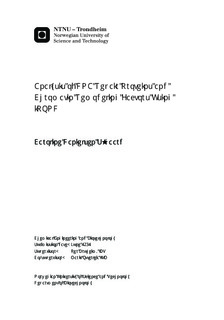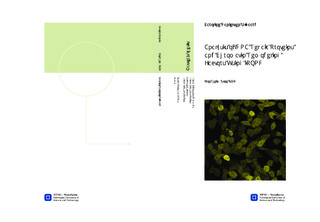| dc.description.abstract | Most chemotherapeutic treatments rely on induction of severe DNA damage to kill the cancer cells. However, DNA repair pathways can repair the induced lesions, leading to survival of the tumor cells. Thus, inhibition of DNA repair pathways may increase the effect of chemotherapeutic drugs. Proliferating cell nuclear antigen (PCNA) functions as a binding platform for many proteins and has an essential role in co-ordination of DNA replication, DNA repair and other crucial processes for cell survival. In 2009, Gilljam and co-workers identified the peptide sequence AlkB homologue 2 PCNA-interacting motif (APIM), important for binding of proteins to PCNA. APIM is found in proteins involved in epigenetics, genome maintenance and cell cycle control, many of which are important after DNA damage. Studies have shown that APIM peptides sensitize cells to DNA damaging agents; hence APIM has a potential in cancer therapy. One hypothesis is that overexpressed APIM blocks the binding sites on PCNA and impairs the binding of APIM-containing proteins to PCNA, thus prevent optimal response to DNA damage.
Isolation of proteins on nascent DNA (iPOND) is a newly developed method for analysis of proteins involved in replication-related processes. The method relies on incorporation of the thymidine analog 5-ethynyl-2?-deoxyuridine (EdU) to nascent DNA. Crosslinking of proteins to DNA and biotin-conjugation to EdU results in biotin-tagged fragments of nascent DNA with bound proteins. The DNA-protein complexes are purified by exploiting the strong binding of biotin to streptavidin, before the proteins are eluted and analyzed by Western blotting.
The aim of this Master thesis has been to optimize iPOND to function with the Flp-INTM T-RexTM-293 APIM-YFP cell line and for the detection of APIM-containing proteins with low abundance close to replication forks. Furthermore, the purpose of this study was to analyze how close proteins involved in epigenetics and DNA repair are to the replisome, and to evaluate if overexpression of APIM affects the presence of these proteins on nascent DNA, both before and after inducing DNA damage.
During optimization of iPOND, it was found that 3x107 cells/dish gives optimal EdU-incorporation and that 2x108 cells/sample is necessary for detection of proteins with low abundance close to replication forks. To maintain the proliferation rate, the cells need to be passaged the day before adding tetracycline, at a concentration of 0,02 µg/mL to induce and sustain APIM-expression. Finally, it was found that 0.5-1 mM methyl methanesulphonate (MMS) introduces DNA damage without excessive stalling of the replication machinery.
iPOND detected proteins involved in nucleotide excision repair (NER) (XPA and XPF)) and direct repair (hABH2) at newly replicated DNA, suggesting a function of these proteins in post-replicative repair. iPOND also verified the chromatin remodeling factors UHRF1 and hSNF5 as replisome proteins and trimethylated H3K9 (H3K9me3) and acetylated H4K16 (H4K16ac) as chromatin-bound proteins. Furthermore, a slightly reduced presence of XPA, hABH2 and hSNF5 (APIM-containing proteins) and of H3K9me3 and H4K16ac on nascent DNA was observed in MMS-treated APIM-expressing cells compared to cells not expressing APIM. The APIM-containing proteins EHMT1 and MRG15 are found in protein complexes that participate in trimethylation of H3K9 and acetylation of H4K16, respectively. Thus, overexpressed APIM seems to perturb the binding of APIM-containing proteins to nascent DNA, and to affect the function of APIM-containing protein complexes responsible for certain histone modifications. | |

